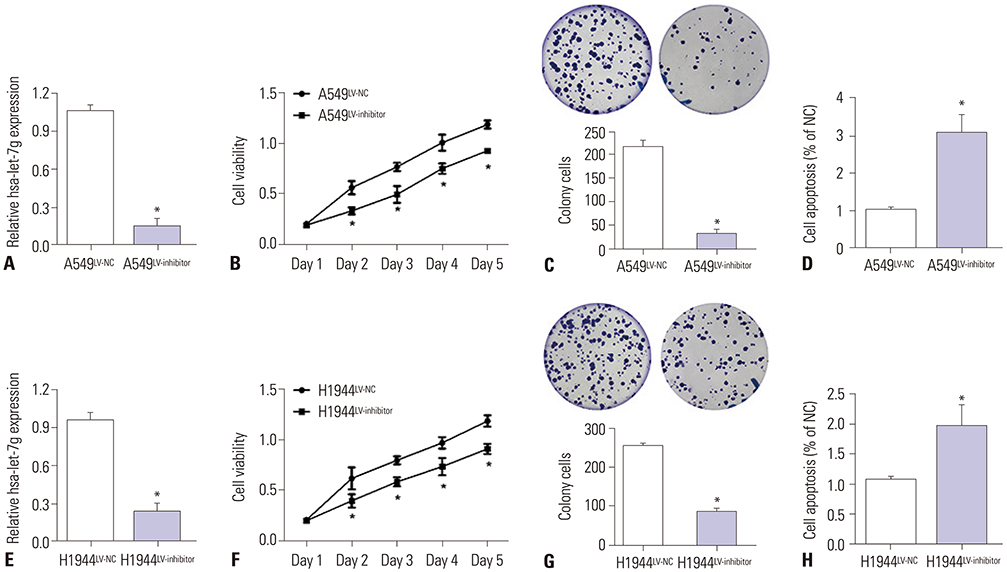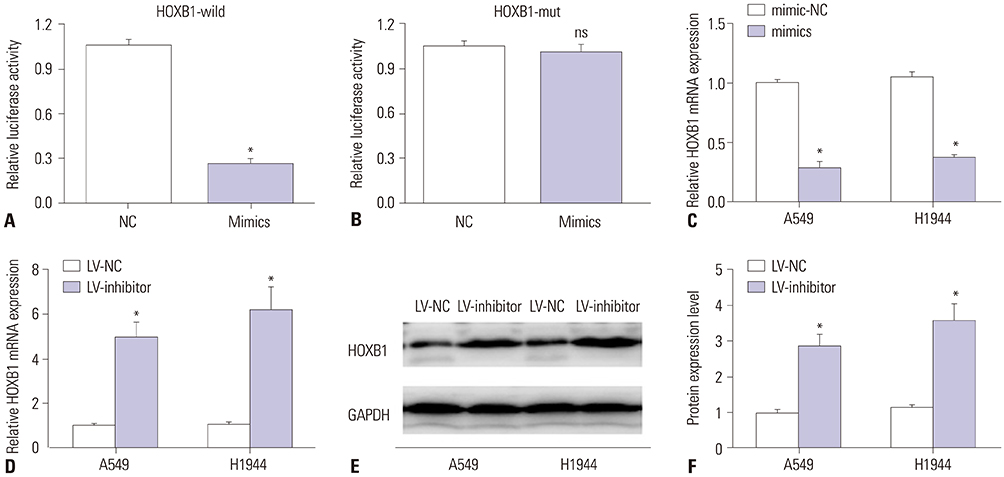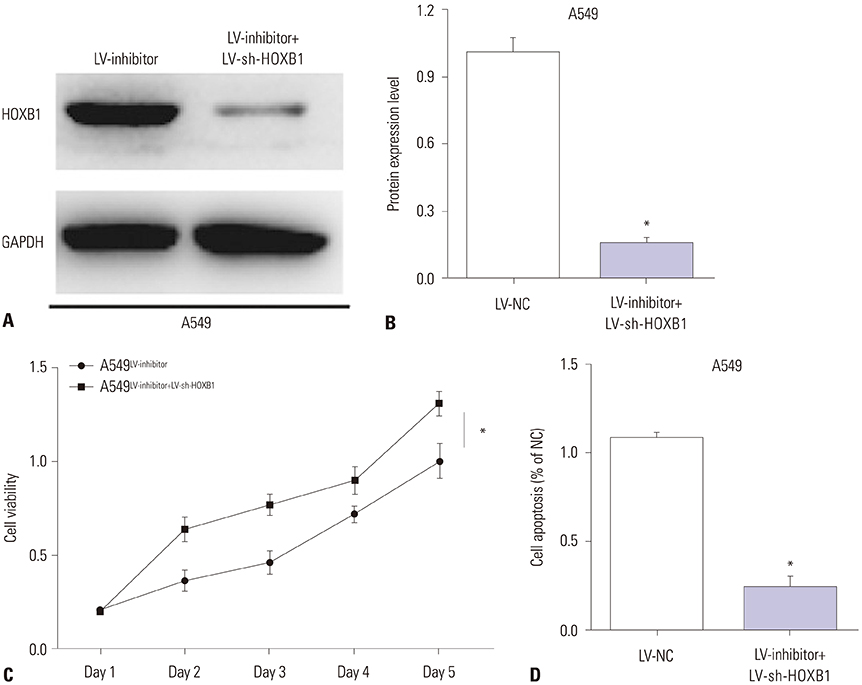Yonsei Med J.
2020 Mar;61(3):210-217. 10.3349/ymj.2020.61.3.210.
The MicroRNA hsa-let-7g Promotes Proliferation and Inhibits Apoptosis in Lung Cancer by Targeting HOXB1
- Affiliations
-
- 1Department of Cardiothoracic Surgery, Jingzhou Central Hospital, The Second Clinical Medical College, Yangtze University, Jingzhou, China. mashengwei1998@126.com
- KMID: 2470917
- DOI: http://doi.org/10.3349/ymj.2020.61.3.210
Abstract
- PURPOSE
The goal of this study was to explore the effects of hsa-let-7g on cell proliferation and apoptosis, and elucidate its role in lung cancer development.
MATERIALS AND METHODS
The expression levels of has-let-7g and HOXB1 in tissues and cells were measured by qRT-PCR. An inhibitor of hsa-let-7g or one targeting a control messenger RNA were transfected into A549 and H1944 lung cancer cells, and the effects of hsa-let-7g dysregulation on cell viability and apoptosis were analyzed using CCK-8 and apoptosis detection assays. HOXB1 was confirmed as the target gene of hsa-let-7g, based on luciferase reporter assay results. The relationship between hsa-let-7g and HOXB1 was confirmed by co-transfection of inhibitors of hsa-let-7g and HOXB1 followed by Western blot, CCK-8, and apoptosis detection assays.
RESULTS
We observed high expression of hsa-let-7g in lung cancer tissues compared to the corresponding normal tissues, and generally higher expression of hsa-let-7g in patients with advanced tumor classification. The results of CCK-8 and apoptosis detection experiments showed that the inhibition of hsa-let-7g significantly inhibited proliferation of A549 and H1944 cells, but also promoted apoptosis. HOXB1 is a specific target of hsa-let-7g, and downregulation of HOXB1 in lung cancer cells reversed the suppressive effects caused by knocking down hsa-let-7g.
CONCLUSION
These data collectively suggest that the expression of hsa-let-7g inhibits lung cancer cells apoptosis and promotes proliferation by down-regulating HOXB1. The results from this study demonstrate the potential of hsa-let-7g/HOXB1 axis as a therapeutic target for the treatment of lung cancer.
Keyword
MeSH Terms
Figure
Reference
-
1. Bray F, Ferlay J, Soerjomataram I, Siegel RL, Torre LA, Jemal A. Global cancer statistics 2018: GLOBOCAN estimates of incidence and mortality worldwide for 36 cancers in 185 countries. CA Cancer J Clin. 2018; 68:394–424.
Article2. Siegel RL, Miller KD, Jemal A. Cancer statistics, 2019. CA Cancer J Clin. 2019; 69:7–34.
Article3. Woodard GA, Jones KD, Jablons DM. Lung cancer staging and prognosis. Cancer Treat Res. 2016; 170:47–75.
Article4. Nasim F, Sabath BF, Eapen GA. Lung cancer. Med Clin North Am. 2019; 103:463–473.
Article5. Cech TR, Steitz JA. The noncoding RNA revolution-trashing old rules to forge new ones. Cell. 2014; 157:77–94.
Article6. Hu X, Feng Y, Zhang D, Zhao SD, Hu Z, Greshock J, et al. A functional genomic approach identifies FAL1 as an oncogenic long noncoding RNA that associates with BMI1 and represses p21 expression in cancer. Cancer Cell. 2014; 26:344–357.
Article7. Martens-Uzunova ES, Böttcher R, Croce CM, Jenster G, Visakorpi T, Calin GA. Long noncoding RNA in prostate, bladder, and kidney cancer. Eur Urol. 2014; 65:1140–1151.
Article8. Del Vescovo V, Denti MA. microRNA and lung cancer. Adv Exp Med Biol. 2015; 889:153–177.9. Li H, Yang T, Shang D, Sun Z. miR-1254 promotes lung cancer cell proliferation by targeting SFRP1. Biomed Pharmacother. 2017; 92:913–918.
Article10. Dimitrova N, Gocheva V, Bhutkar A, Resnick R, Jong RM, Miller KM, et al. Stromal expression of miR-143/145 promotes neoangiogenesis in lung cancer development. Cancer Discov. 2016; 6:188–201.
Article11. Yang Y, Ding L, Hu Q, Xia J, Sun J, Wang X, et al. MicroRNA-218 functions as a tumor suppressor in lung cancer by targeting IL-6/ STAT3 and negatively correlates with poor prognosis. Mol Cancer. 2017; 16:141.
Article12. Hu H, Zhao X, Jin Z, Hou M. Hsa-let-7g miRNA regulates the antitumor effects of gastric cancer cells under oxidative stress through the expression of DDR genes. J Toxicol Sci. 2015; 40:329–338.
Article13. Nakajima G, Hayashi K, Xi Y, Kudo K, Uchida K, Takasaki K, et al. Non-coding microRNAs hsa-let-7g and hsa-miR-181b are associated with chemoresponse to S-1 in colon cancer. Cancer Genomics Proteomics. 2006; 3:317–324.14. Hu H, Zhang L, Teng G, Wu Y, Chen Y. A variant in 3′-untranslated region of KRAS compromises its interaction with hsa-let-7g and contributes to the development of lung cancer in patients with COPD. Int J Chron Obstruct Pulmon Dis. 2015; 10:1641–1649.15. Han L, Liu D, Li Z, Tian N, Han Z, Wang G, et al. HOXB1 is a tumor suppressor gene regulated by miR-3175 in glioma. PLoS One. 2015; 10:e0142387.
Article16. Roux M, Laforest B, Eudes N, Bertrand N, Stefanovic S, Zaffran S. Hoxa1 and Hoxb1 are required for pharyngeal arch artery development. Mech Dev. 2017; 143:1–8.
Article17. Morgan R, Boxall A, Harrington KJ, Simpson GR, Gillett C, Michael A, et al. Targeting the HOX/PBX dimer in breast cancer. Breast Cancer Res Treat. 2012; 136:389–398.
Article18. Guazzi S, Pintonello ML, Viganò A, Boncinelli E. Regulatory interactions between the human HOXB1, HOXB2, and HOXB3 proteins and the upstream sequence of the Otx2 gene in embryonal carcinoma cells. J Biol Chem. 1998; 273:11092–11099.
Article19. Zhou JL, Deng S, Fang HS, Yu G, Peng H. Hsa-let-7g promotes osteosarcoma by reducing HOXB1 to activate NF-κB pathway. Biomed Pharmacother. 2019; 109:2335–2341.
Article20. Tafrihi M, Hasheminasab E. MiRNAs: biology, biogenesis, their web-based tools, and databases. Microrna. 2019; 8:4–27.
Article21. Rupaimoole R, Slack FJ. MicroRNA therapeutics: towards a new era for the management of cancer and other diseases. Nat Rev Drug Discov. 2017; 16:203–222.
Article22. Xu G, Zhang Z, Zhang L, Chen Y, Li N, Lv Y, et al. miR-4326 promotes lung cancer cell proliferation through targeting tumor suppressor APC2. Mol Cell Biochem. 2018; 443:151–157.
Article23. Jiang LP, Zhu ZT, He CY. Expression of miRNA-26b in the diagnosis and prognosis of patients with non-small-cell lung cancer. Future Oncol. 2016; 12:1105–1115.
Article24. Li J, Jin H, Yu H, Wang B, Tang J. miRNA 1284 inhibits cell growth and induces apoptosis of lung cancer cells. Mol Med Rep. 2017; 16:3049–3054.
Article25. Lan FF, Wang H, Chen YC, Chan CY, Ng SS, Li K, et al. Hsa-let-7g inhibits proliferation of hepatocellular carcinoma cells by downregulation of c-Myc and upregulation of p16 (INK4A). Int J Cancer. 2011; 128:319–331.
Article26. Wang L, Li M, Zhou Y, Zhao Y. MicroRNA let-7g directly targets forkhead Box C2 (FOXC2) to modulate bone metastasis in breast cancer. Open Med (Wars). 2017; 12:157–162.
Article27. Salmena L, Poliseno L, Tay Y, Kats L, Pandolfi PP. A ceRNA hypothesis: the Rosetta Stone of a hidden RNA language? Cell. 2011; 146:353–358.
Article28. Arenkiel BR, Tvrdik P, Gaufo GO, Capecchi MR. Hoxb1 functions in both motoneurons and in tissues of the periphery to establish and maintain the proper neuronal circuitry. Genes Dev. 2004; 18:1539–1552.
Article29. Roux M, Laforest B, Capecchi M, Bertrand N, Zaffran S. Hoxb1 regulates proliferation and differentiation of second heart field progenitors in pharyngeal mesoderm and genetically interacts with Hoxa1 during cardiac outflow tract development. Dev Biol. 2015; 406:247–258.
Article30. López R, Garrido E, Piña P, Hidalgo A, Lazos M, Ochoa R, et al. HOXB homeobox gene expression in cervical carcinoma. Int J Gynecol Cancer. 2006; 16:329–335.
Article
- Full Text Links
- Actions
-
Cited
- CITED
-
- Close
- Share
- Similar articles
-
- MicroRNA-98-5p Inhibits Tumorigenesis of Hepatitis B Virus-Related Hepatocellular Carcinoma by Targeting NF-κB-Inducing Kinase
- LncRNA Taurine-Upregulated Gene 1 Promotes Cell Proliferation by Inhibiting MicroRNA-9 in MCF-7 Cells
- LIN28B confers radio-resistance through the posttranscriptional control of KRAS
- Regulation of microRNA-7-5p and LRP6 by Epstein-Barr Virus-Encoded RNAs in Burkitt's Lymphoma Cell Line Akata
- Hsa-miRNA-143-3p Reverses Multidrug Resistance of Triple-Negative Breast Cancer by Inhibiting the Expression of Its Target Protein Cytokine-Induced Apoptosis Inhibitor 1 In Vivo






